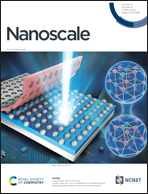Natural flagella-templated Au nanowires as a novel adjuvant against Listeria monocytogenes
Abstract
A simple method was developed for the extraction and purification of bacterial flagella with a yield of a concentration of 113.22 ± 5.64 mg mL−1. Gold (Au) nanowires were synthesized using the bacterial flagella as the template. Transmission Electron Microscopy (TEM) analysis showed that the nanowires were scarcely clustered as stiff (no tendency to bend or fold) and straight nanorods with homogeneous surface and a uniform aspect ratio over 60. Fourier Transform Infrared (FT-IR) spectroscopic studies revealed the deep involvement of the functional groups located within and on the surface of flagellin, including C–N, N–H, O–H, and C![[double bond, length as m-dash]](https://www.rsc.org/images/entities/char_e001.gif) O. The profound transformation observed in the absorption profiles of these groups supported the notion that both chemical (reduction) reaction and physical (electrostatic) binding of Au occurred during the formation of Au nanowires. Verbascoside, oleuropein, and olive leaf extract (OLE) have been shown to inhibit the growth of Listeria monocytogenes completely at their respective Minimal Inhibitory Concentrations (MICs) of 20, 64, and 64 mg mL−1. In contrast, the synthesized Au nanowires demonstrated high electrocatalytic activity and reduced the MICs of the three antibacterial compounds by half. Moreover, results from the AMES assays indicated that the synthesized Au nanowires had no mutagenic activities at the catalytic concentration used, 128 μg mL−1. Therefore, the Au nanowires fabricated in this work have the potential to be used as new antimicrobial food packaging materials to enhance food safety.
O. The profound transformation observed in the absorption profiles of these groups supported the notion that both chemical (reduction) reaction and physical (electrostatic) binding of Au occurred during the formation of Au nanowires. Verbascoside, oleuropein, and olive leaf extract (OLE) have been shown to inhibit the growth of Listeria monocytogenes completely at their respective Minimal Inhibitory Concentrations (MICs) of 20, 64, and 64 mg mL−1. In contrast, the synthesized Au nanowires demonstrated high electrocatalytic activity and reduced the MICs of the three antibacterial compounds by half. Moreover, results from the AMES assays indicated that the synthesized Au nanowires had no mutagenic activities at the catalytic concentration used, 128 μg mL−1. Therefore, the Au nanowires fabricated in this work have the potential to be used as new antimicrobial food packaging materials to enhance food safety.



 Please wait while we load your content...
Please wait while we load your content...